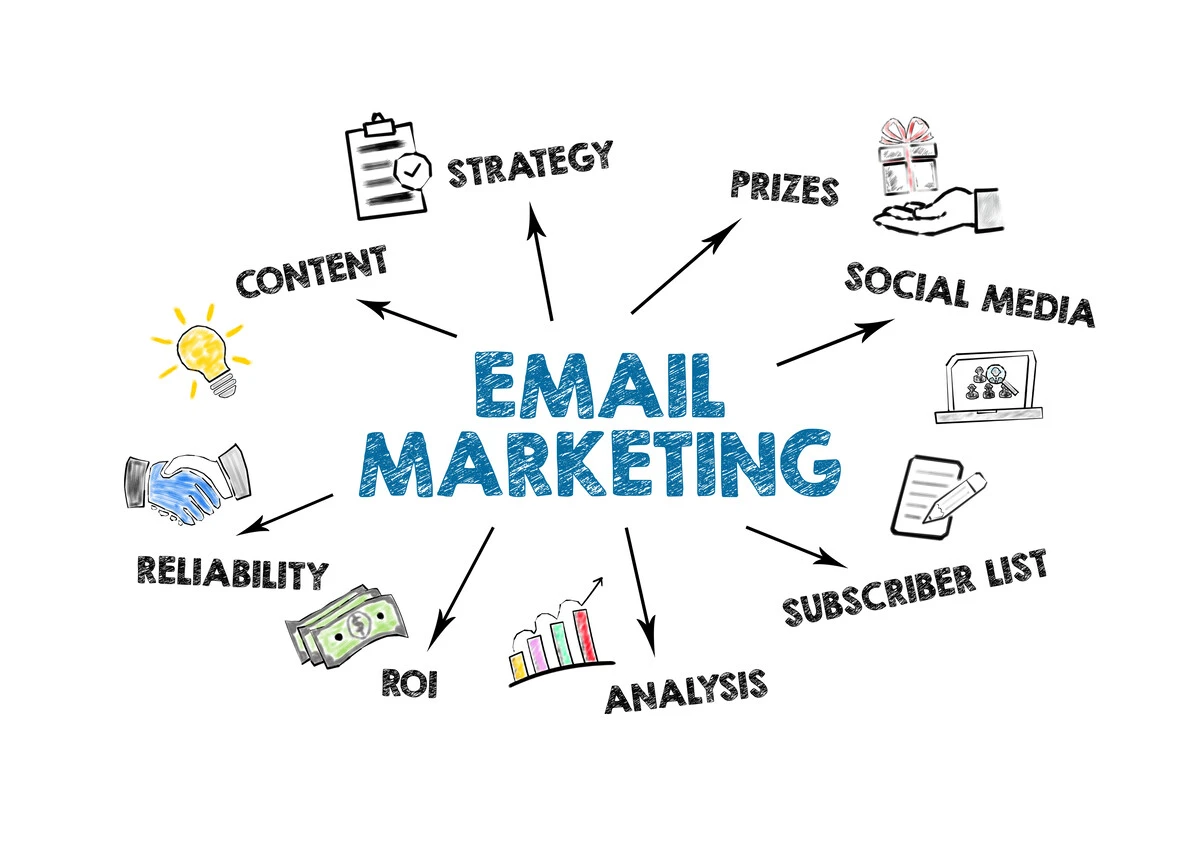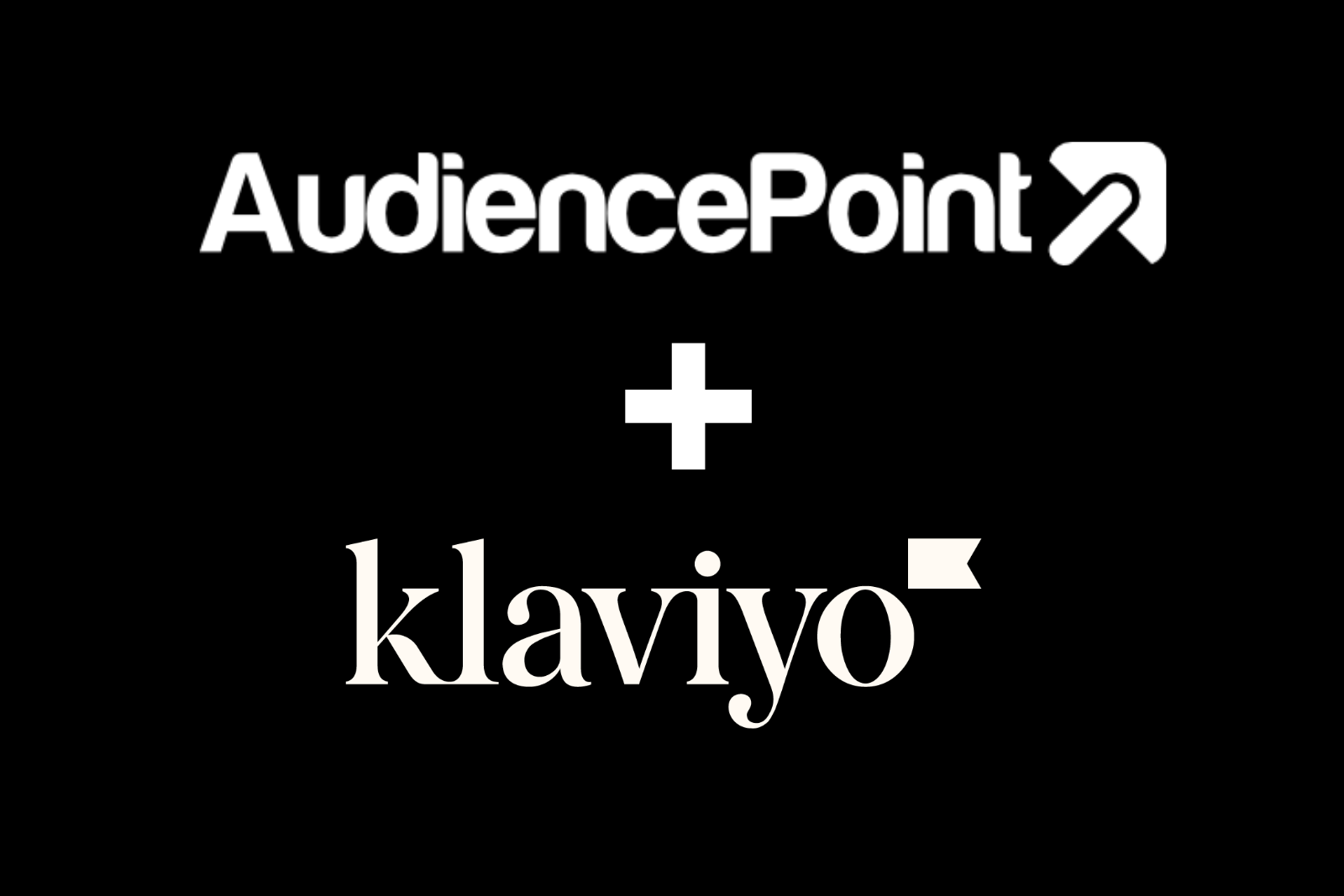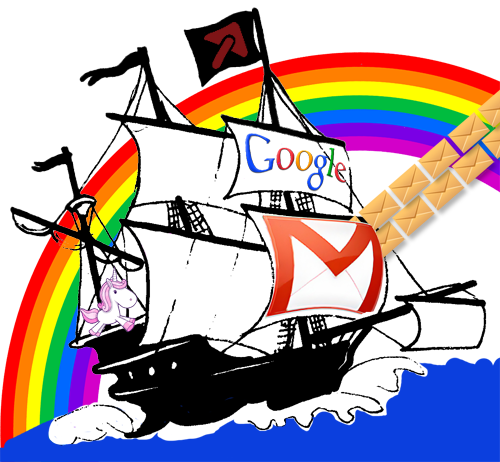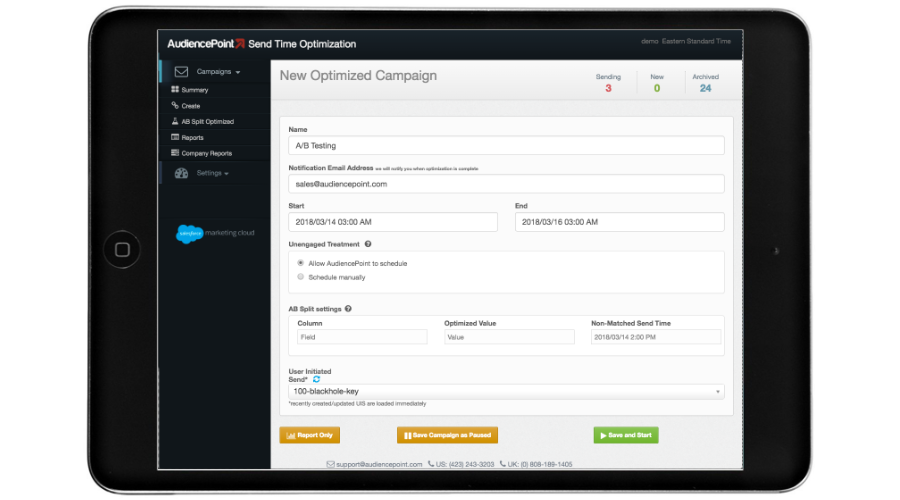AudiencePoint is thrilled to announce our new integration with Klaviyo! AudiencePoint is looking for partners to pilot our...
Understanding the Trend
As we look at email marketing trends in 2025, the landscape of email marketing is set to undergo transformative changes driven by advancements in AI (Artificial Intelligence) and automation. These trends will enable marketers to craft more personalized and impactful campaigns that resonate with their target audience, making email marketing an essential component of a comprehensive digital marketing strategy.
Increased use of AI and machine learning
The integration of AI and machine learning is unlocking unprecedented potential for email marketers. These technologies scan large data sets to predict how potential customers will behave, letting brands time and shape each email for maximum relevance while boosting overall campaign performance. AI can refine the timing and content of emails, ensuring that messages are relevant and likely to engage the recipient. This level of sophistication means that marketers can move beyond manual segmentation to a more dynamic, real-time approach.
Advanced automation tools and platforms
Automation continues to evolve, offering advanced email automation tools that simplify and optimize many aspects of email marketing. Marketers can now deploy sophisticated workflows that trigger based on user behavior, making the process of nurturing leads and maintaining customer relationships more efficient and effective. Automation platforms are focusing on reducing repetitive tasks and empowering marketers to focus on strategy and creativity.
Modern platforms automatically send welcome emails to greet new subscribers, followed by timely transactional emails such as order confirmations or password resets, ensuring every interaction feels polished and personal.
Enhanced personalization and segmentation
Email marketing in 2025 will be characterized by a deeper level of personalization. Marketers now move beyond basic segmentation to deliver targeted messages that reflect each subscriber’s detailed profile and interaction history, resulting in higher engagement and conversion rates. This shift is enabled by improved data collection and analysis techniques, allowing companies to deliver messages that truly resonate with their audience, increasing engagement and conversion rates. These advancements are crucial for creating and executing effective email marketing campaigns.
Integration with other digital marketing channels
Email is no longer an isolated marketing channel. In 2025, it will be seamlessly integrated with various other digital marketing strategies. By combining email marketing efforts with social media, content marketing, and paid advertising, marketers can create a cohesive brand message that reaches consumers across multiple touchpoints. Such integration allows for more consistent branding and a more comprehensive view of customer interactions.
Focus on data privacy and compliance.
With increasing regulations around data privacy, marketers are more vigilant about adhering to compliance standards. In 2025, email marketing strategies will emphasize respecting user data and obtaining explicit consent for communications. Successful marketers will balance personalization with privacy, utilizing data responsibly while delivering value to their subscribers. Additionally, using an email service provider effectively involves regular list hygiene practices, such as removing invalid addresses and monitoring engagement to protect the sending reputation of the provider.
These trends highlight a substantial shift in how email marketing will function in the near future. For email marketers, understanding and leveraging these trends is not just an option but a necessity to sustain success. AudiencePoint provides a platform that encapsulates these developments, offering tools that adapt to the evolving digital marketing ecosystem, ensuring your email strategy remains cutting-edge and effective.
What Is the 80/20 Rule in Email Marketing?
The 80/20 rule in email marketing is a guiding principle that suggests that 80% of your email content should be valuable, informative, or engaging to your audience, while 20% can be promotional. This rule is designed to maintain a balance in your emails, ensuring your subscribers find value in your communications, which can lead to better engagement and conversion rates.
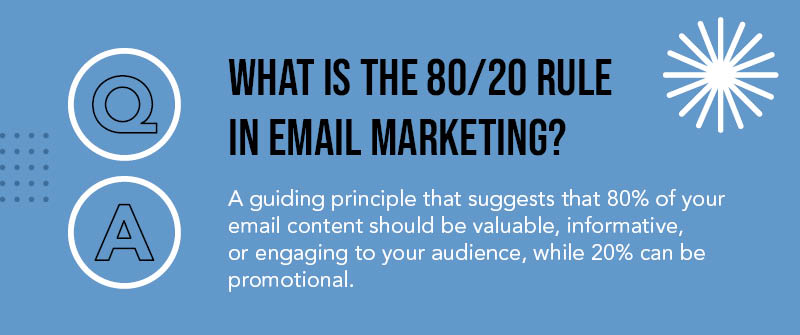
Explanation of the 80/20 Rule in Marketing
At its core, the 80/20 rule, also known as the Pareto Principle, applies beyond just marketing to describe any situation where a small percentage of input is responsible for a majority of effects. In marketing, it is used to emphasize the importance of providing value to consumers rather than overwhelming them with promotional messages. Originally applied in economics by Vilfredo Pareto, this concept has since been adapted to various fields, including email marketing.
Application to Email Marketing Content
Applying the 80/20 rule to email marketing strategy involves crafting emails where the main focus is on delivering content that educates, entertains, or otherwise serves the needs of your audience. This content might include tips, industry news, case studies, or personal stories that resonate with your subscribers. By doing so, you build a relationship of trust and reliability, which is crucial for maintaining high open and click-through rates. Incorporating email marketing best practices ensures that your efforts are optimized for engagement and effectiveness.
Balancing Promotional and Value-Driven Content
The 20% promotional content is where you present your offers and calls to action. Balancing these offers with 80% of content that establishes context and relationships ensures that when you do promote your products, your audience is more receptive. They’re already invested in the value you provide and are more likely to respond positively to your offers, thereby improving conversion rates.
Strategies for Efficient Audience Engagement
To efficiently engage your audience using the 80/20 rule, it’s essential to understand your audience’s preferences and pain points through data analysis. Tools like AudiencePoint’s email insight software can assist in tracking subscriber behavior to refine how you balance your content. This helps in creating a strategy that not only respects the 80/20 division but maximizes its effectiveness. AudiencePoint offers insights to optimize the timing, frequency, and content of your emails based on real subscriber interaction, increasing the chances of maintaining strong engagement over time.
Is There a Future for Email Marketing?
The future of email marketing is promising as it continues to adapt and thrive in the ever-evolving digital marketing landscape. Despite the rising popularity of social media and instant messaging platforms, when it come to email marketing vs social media, email marketing remains a steadfast channel, leveraging its unique strengths to maintain relevance and effectiveness.
Evolution and Resilience of Email Marketing
Throughout its history, email marketing has continuously evolved, showcasing remarkable resilience by integrating new technologies and strategies. It has transitioned from basic mass emailing techniques to sophisticated, data-driven campaigns that prioritize customer engagement and satisfaction. This ability to innovate is key to its survival and future growth.
Adaptation to Changing Digital Marketing Landscapes
As part of the digital marketing ecosystem, email marketing has adeptly responded to shifts such as the increased focus on mobile optimization and integration with other channels like social media. The flexibility to complement other marketing tactics and the necessity to optimize for mobile devices, given that a significant percentage of emails are opened on them, has ensured its continued relevance as an indispensable tool for marketers.
Role of Personalization and Analytics in Future Growth
The drive for deeper, more meaningful customer connections has placed email personalization at the forefront of successful campaigns. By employing advanced analytics, marketers can craft personalized messages tailored to individual preferences—a trend likely to expand as technology advances, enhancing customer experiences and driving higher engagement rates. Engaging with email subscribers through personalized content and targeted strategies will further optimize marketing efforts and improve overall performance.
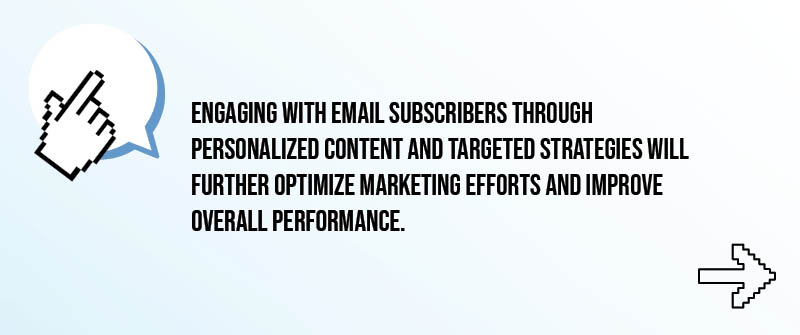
Innovations Enhancing Email Marketing Effectiveness
Innovations such as artificial intelligence (AI) and machine learning are set to revolutionize email marketing further. These technologies enable enhanced audience segmentation, predictive analytics, and automation, ensuring more effective targeting and engagement. Incorporating AI-based insights allows marketers to anticipate customer needs, refine content strategies, and improve campaign outcomes. Re-engagement campaigns are also vital for targeting inactive subscribers, using tailored content, optimized subject lines, and automation to revive interest and maintain an engaged subscriber list.
In conclusion, email marketing’s adaptability, enhanced by technological advancements and the increasing importance of personalization, assures its position as a core marketing strategy. For marketers seeking to maximize their outreach and engagement, leveraging tools like AudiencePoint is crucial. AudiencePoint provides insights into subscriber engagement, helping optimize campaign strategies to ensure emails not only reach inboxes but also resonate with recipients, driving meaningful interactions and business growth.
What Are the 5 T’s of Email Marketing?
The 5 T’s of email marketing act as a strategic framework guiding email marketers to craft campaigns that are not only effective but also resonate well with their audiences. Understanding these elements can significantly bolster your strategy, ensuring your messages hit the mark every time.
Targeting: Precision in Audience Segmentation
Effective email marketing begins with precise targeting. By segmenting your audience based on demographics, behaviors, or past interactions, you can create personalized campaigns that speak directly to your recipients’ needs. AudiencePoint excels in this arena, offering insights that help refine your list for better engagement.
Timing: Optimal Delivery Scheduling
The timing of when you send an email can dramatically affect its open and click-through rates. Optimizing delivery times based on when your audience is most responsive can be the difference between an email read and an email ignored. Tools like AudiencePoint provide analytical insights that highlight the most effective times to reach your subscribers.
Testing: Importance of A/B Testing
Testing your emails through A/B testing is vital to understanding what works best for your audience. By experimenting with different email subject lines, content, or layouts, you can fine-tune your messages to improve performance. Regular testing helps you stay aligned with your audience’s preferences and maximize engagement.
Tracking: Utilizing Advanced Analytics
Tracking is the cornerstone of understanding your email campaigns’ effectiveness. By utilizing advanced analytics, you can monitor open rates, click-through rates, and conversion metrics. Insights from AudiencePoint provide email marketers with the data needed to refine their strategies and improve results continually.
Transformation: Adapting Strategies for Modern Audiences
Transformation is about constantly evolving your email strategies to meet the expectations of modern audiences. As technology and consumer preferences evolve, so must your approach. AudiencePoint aids marketers in keeping their strategies fresh and relevant, ensuring continued success in an ever-changing landscape.
Implementing the 5 T’s of email marketing ensures that your campaigns are scientifically designed to meet the goals of acquisition, retention, and engagement effectively. With AudiencePoint’s robust tools supporting these frameworks, email marketers are well-equipped to outshine their competition.
Building an Effective Email Marketing Strategy
Crafting an effective email marketing strategy involves a multifaceted approach centered around clear objectives, leveraging the right tools, and ongoing performance refinement. To achieve optimal results and fully engage your audience, it’s imperative that email marketers strategically plan their campaigns by anchoring them on well-defined goals and objectives.
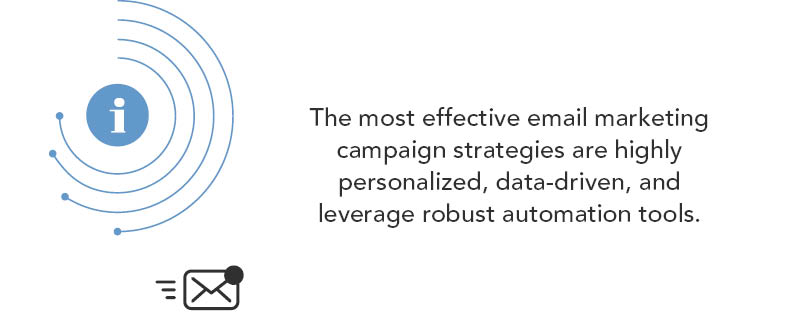
What is the most effective email marketing campaign strategy?
The most effective email marketing campaign strategies are highly personalized, data-driven, and leverage robust automation tools. Marketers must define clear campaigns with measurable goals, refine their approach based on in-depth analysis, and utilize email marketing platforms for enhanced customer engagement. By focusing on delivering personalized, relevant content to segmented audiences, businesses can maximize their email campaigns’ impact, thereby increasing open rates, click-through rates, and, ultimately, boosting conversions. Successful email marketing campaigns hinge on effective audience segmentation, which involves grouping subscribers based on their interests and behaviors.
Defining Clear Goals and Objectives
The foundation of any successful email marketing strategy begins with clearly defining what you want to achieve. Whether your focus is on increasing sales, generating leads, or boosting customer engagement, setting specific and actionable goals allows for tailored email campaigns that resonate with your target audience. Establishing these objectives will ensure that your strategy is aligned with your broader business goals.
Utilization of Email Marketing Platforms and Tools
Email marketers can greatly benefit from modern platforms and tools that automate workflows, from scheduling and managing customer journeys to segmenting audiences. These resources save time and enhance precision by allowing marketers to focus on creating engaging content and refining strategic approaches. With platforms like AudiencePoint, companies can schedule targeted emails, seamlessly integrate personalized content, and efficiently manage the hygiene of email lists.
Analyzing Successful Email Marketing Strategy Examples
Learning from diverse email marketing strategies that have delivered impressive results is a great way to elevate your campaigns. Analyzing examples where detailed segmentation, compelling transitional CTAs, and strong value propositions were successfully executed can provide valuable insights into constructing your campaigns. Leveraging case studies to understand what has worked can guide strategic planning and optimization.
Incorporating Value-Driven Content and Consistent Branding
Value-driven content is key to engaging your audience. This involves offering content that not only promotes products or services but also delivers valuable insights or solutions to your recipients’ needs. Consistent branding across all email communications fosters trust and brand recognition, ensuring that your audience feels connected and familiar with your brand’s voice and visual style.
Continuous Performance Monitoring and Strategy Refinement
Ongoing analysis is crucial. Regularly track metrics such as open rates, click-through rates, and conversion rates to identify areas for improvement. A/B testing can be a useful method for measuring the impact of different strategies, ensuring your emails consistently perform well. This data-driven approach enables marketers to refine their strategies continually, adapting to changes in consumer behavior and market trends.
Enhance your email marketing campaigns with AudiencePoint’s unrivaled understanding of subscriber behavior. Uncover hidden insights to supercharge deliverability, fuel re-engagement efforts, and perfect your IP warming techniques, ultimately boosting your revenue potential and securing a significant market advantage. Contact AudiencePoint Today!
